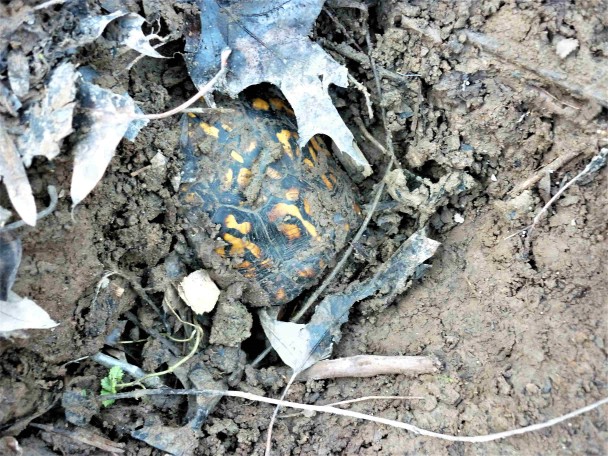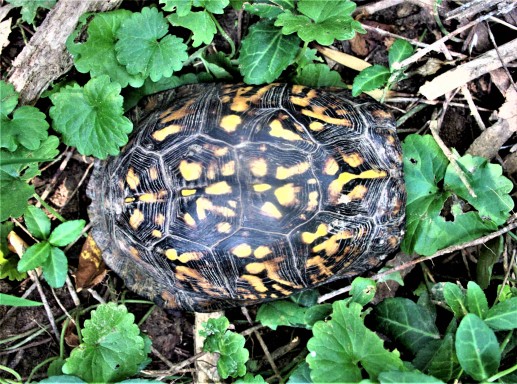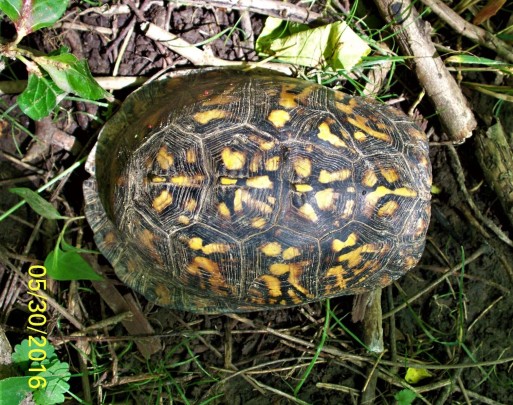(this post was started Friday evening)
Yesterday I was thinking about box turtles. After such very warm weather it seemed likely that a few adventurous chelonians might be up and about already. Little did I know that today I’d be the cause of one poor turtle waking up rather suddenly.

This afternoon I had a small bucket of young elderberry roots I’d been transplanting to an area safe from deer. Fearing an overnight freeze, I looked for a hole to shelter the bucket in till morning. A couple weeks ago I’d emptied some soil into the little sinkhole-looking low spot in the picture above. It would be an easy place to set the bucket in. Removing a first shovelful of loose soil, I saw this bright yellow pattern and realized with dismay what I had done!

Apparently I’d discovered the hibernaculum of a box turtle. Or had I – remember the loose soil? More about that later.
The poor turtle peeked out of it’s carapace with, so it seemed to me, an anguished look, then with a pneumatic hiss slammed shut. (That’s the sound of air leaving their lungs). I quickly took a picture and replaced the soil just as it was before. Interestingly, this turtle was not very far below the surface.
I had a feeling we’d met before, and confirmed it by looking through my turtle data book. Sure enough, he was box turtle # 115, 143, 182. This means I’ve seen him at least three times, and documented his activities in the notebook.

Pic above is the notebook page from 9/6/15, the first time the turtle and I met. The location was less than 200 feet from the hibernaculum, not surprising for the homebody box turtle. Look closely at the pic below and you’ll see something unique – this particular turtle has an extra “scute”, or scale. It is triangular and located on the left side of the carapace (see notebook page drawing). This is uncommon but not rare, and I’ve seen three turtles with such anomalies in our forest.

By the look of the plastron, or underside, this is an older turtle. He is worn quite smooth from decades of crawling over the forest floor. You can tell he’s a male from the center concavity, which helps him balance on a female’s back during mating.

Our next encounter was on 5/30/16, and he was in the company of another male turtle – again less than 200 feet (in a different direction) from the hibernaculum. I can bet these encounters are a lot more fun for me than the turtles. They get held down for a tracing on the data book page, placed on their back for a plastron picture, and finally dabbed on the rear with a spot of green nail polish.

Some box turtles struggle mightily during this process, most just stay closed up. I’ve been keeping these records since 2013, and have recorded 182 encounters – likely amounting to over 130 individuals since many are sighted multiple times. The trick to meeting so many turtles is working off trail removing invasive plants. It’s a tedious chore but it has some perks! Hopefully, over time this data will yield some insights into our amazingly urban box turtle population, and how to keep them thriving.
This old guy with the extra scute seems to be doing pretty well, and finds everything he needs within a very small area. He’s lucky to live in prime box turtle habitat, a moist lowland near a spring. But I’m still puzzled by one thing – was the place I dug him up really his hibernaculum, or had he retreated to that hole after coming up briefly during the early spell of warm weather? Fresh soil had been emptied into the hole a few weeks ago, and he was not down very deep.
This is a particularly timely question, since we now know late winter warm spells are likely to be a common thing (or warm spells anytime in winter, for that matter). Box turtles may become active more frequently during these times, since they do not “sleep” in the way a hibernating mammal does. Their winter dormancy is called brumation, and it’s really a period of inactivity due to low temperature. I have observed the two captive box turtles in the LNC’s outdoor enclosure emerging, retreating, and emerging again as spring progresses. Winters will become more unpredictable, but we may hope a species that’s been on the planet for 15 million years knows how to deal with change.


Phyllis Fitzgerald
I love this information, and am so happy you are recording it! I am also happy these box turtles are in the Preserve instead of my garden, munching on tomatoes!
LikeLike
oneforestfragment
Box turtles have actually been in our yard, and last year one was walking across Blvd Napoleon . It is possible for them to live in our personal landscapes, fragmented as they are. Or, some could be unwilling refugees form the woods carried off by children! Rosemary
LikeLike